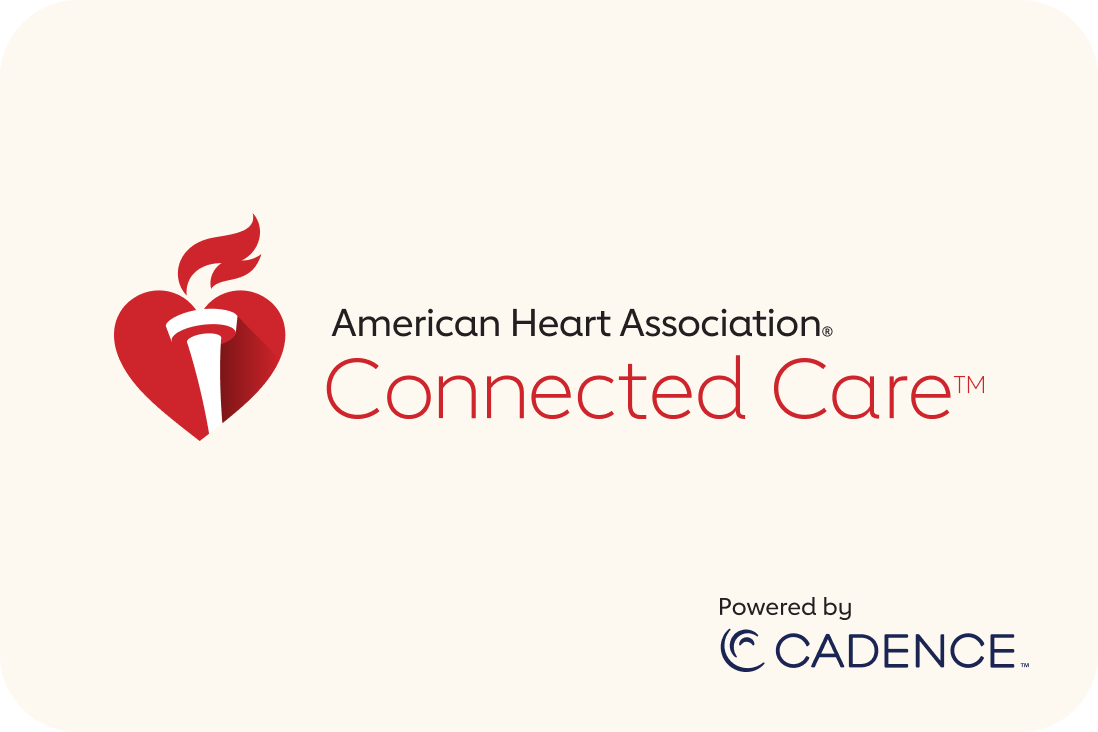Novel virtual care program enhances at-home support for people with heart failure

“American Heart Association Connected Care™, Powered by Cadence” closes gaps in care by providing healthcare access to those who need it most
DALLAS, Aug. 26, 2025 – With chronic disease rates rising across the U.S., healthcare systems face ongoing challenges in reducing hospital stays and readmissions (1). Nearly 1 in 4 heart failure patients is readmitted to the hospital within 30 days of discharge (2), and fewer than 20% receive all four guideline-directed medical therapy pillars post-discharge, despite strong evidence showing these therapies improve patient outcomes (3).
At the same time, the number of people living with chronic illness is expected to double from 2020 to 2050 (4). Remote patient care fills a critical gap, offering a scalable way to support the most vulnerable patients, improving adherence to evidence-based care and reducing avoidable hospitalizations, no matter the geographical location.
To help close critical gaps in heart failure care, the American Heart Association, a relentless force changing the future of health for everyone everywhere, has developed American Heart Association Connected Care™, Powered by Cadence, a virtual care program that delivers ongoing heart and cardiometabolic care to patients at home after their hospital stay.
Hospitals can refer eligible patients to the Connected Care program prior to discharge. The Association is working with participating hospitals to integrate the program into discharge workflows. Cadence enrolls patients in the program, teaching them how to use their devices, monitoring vital sign readings and providing ongoing clinical support.
“Our legacy is built on bringing science to life and meeting people where they are to reimagine how healthcare is delivered,” said John Meiners, chief of mission-aligned businesses at the American Heart Association. “By combining advanced remote patient monitoring technology with our expertise in guideline-directed care and chronic condition management, we can help extend the high-quality care hospitals provide, ensuring people with heart failure receive proactive, timely support at home when they need it most.”
The Association spearheaded this collaboration with Cadence to extend the reach of its trusted science into homes and communities, utilizing Cadence’s remote platform and 24/7 virtual provider group.
“Hospitals struggle to extend consistent, evidence-based care once patients leave their doors,” said Chris Altchek, chief executive officer and founder of Cadence. “By pairing the American Heart Association’s gold-standard scientific guidelines with Cadence’s AI-driven remote monitoring and always-on care team, American Heart Association Connected Care, Powered by Cadence, makes proactive, personalized heart-failure support available anytime, anywhere.”
American Heart Association Connected Care aims to:
· Reduce 30-day readmissions for people with heart failure by providing peace of mind and timely interventions for patients and their families.
· Support heart failure patients from hospital admission through safe discharge and recovery at home.
· Bring care to more communities by delivering personalized support beyond hospital walls.
“Too often, people with heart failure get discharged from the hospital only to find themselves back within a month,” said Marat Fudim, M.D., MHS, associate professor of medicine at Duke University School of Medicine and heart failure cardiologist at the Duke University Medical Center. “With timely interventions and evidence-based support, remote patient monitoring allows us to bridge that gap by keeping a close eye on patients’ health while they’re at home, avoiding unnecessary hospitalizations and achieving better long-term outcomes.”
Rooted in a century of innovative scientific breakthroughs, trusted clinical guidelines and science-backed educational content, Connected Care offers patients timely, remote care and support to help them adhere to treatment plans, adopt heart-healthy habits and avoid preventable readmissions.
The Connected Care pilot program is currently underway at four hospitals:
· Texas Health Allen, Texas Health Resources – Allen, T.X.
· Rutherford Regional Health System, Lifepoint Health – Rutherfordton, N.C.
· Frye Regional Medical Center, Lifepoint Health – Hickory, N.C.
· Community Hospital of the Monterey Peninsula, Montage Health – Monterey, C.A.
Additional Resources:
· AmericanHeart Association Connected Care: www.heart.org/ahaconnectedcare.
· Circulation: National Patterns of Remote Patient Monitoring Service Availability at US Hospitals
###
About the American Heart Association
The American Heart Association is a relentless force for a world of longer, healthier lives. Dedicated to ensuring equitable health in all communities, the organization has been a leading source of health information for more than one hundred years. Supported by more than 35 million volunteers globally, we fund groundbreaking research, advocate for the public’s health, and provide critical resources to save and improve lives affected by cardiovascular disease and stroke. By driving breakthroughs and implementing proven solutions in science, policy, and care, we work tirelessly to advance health and transform lives every day. Connect with us on heart.org, Facebook, X or by calling 1-800-AHA-USA1.
[1] Kripalani S, Theobald CN,Anctil B, Vasilevskis EE. Reducing hospital readmission rates: current strategies and future directions. Annu Rev Med. 2014;65:471-85. doi:10.1146/annurev-med-022613-090415.
[2] Khan, Muhammad Shahzeb, Sreenivasan, Jayakumar, et al. Trends in 30- and 90-Day Readmission Rates forHeart Failure. 2021. Circulation: Heart Failure. Vol 14. No 4.doi:10.1161/CIRCHEARTFAILURE.121.008335.https://www.ahajournals.org/doi/abs/10.1161/CIRCHEARTFAILURE.121.008335.
[3] Jacobs, Joshua A., Ayodele, Iyanuoluwa, et al. Social Determinants of Health and Disparities inGuideline-Directed Medical Therapy Optimization for Heart Failure. 2025.Circulation: Heart Failure. Vol 18 No 1.doi:10.1161/CIRCHEARTFAILURE.124.012357. https://www.ahajournals.org/doi/abs/10.1161/CIRCHEARTFAILURE.124.012357.
[4] Ansah JP, Chiu CT. Projectingthe chronic disease burden among the adult population in the United States using a multi-state population model. Front Public Health. 2023 Jan13;10:1082183. doi: 10.3389/fpubh.2022.1082183.






